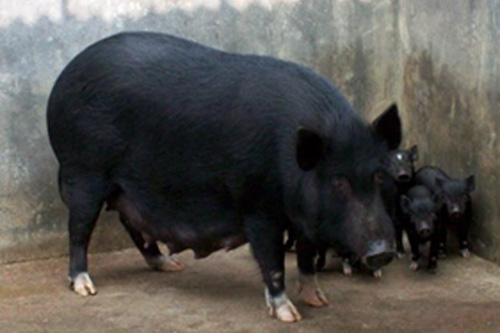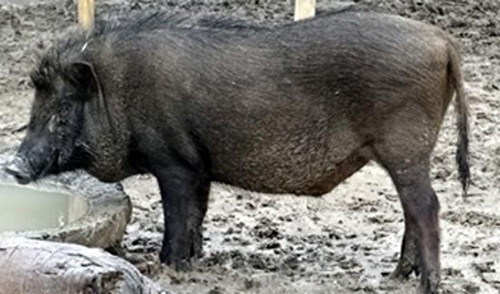ICAR-National Bureau of Animal Genetic Resources, Karnal (NBAGR) is the nodal agency for the registration of newly identified germplasm of livestock and poultry of the country. Newly identified breeds are approved by Breed Registration Committee (BRC) of Indian Council of Agricultural Research (ICAR) headed by Deputy Director General (Animal Sciences), ICAR and represented by National Biodiversity Authority, Department of Animal Husbandry & Dairying (GoI), ADGs (ICAR), Directors of ICARs species specific animal science institutes and NBAGR.
Breed registration Committee in its meeting held on 24th January, 2020 at New Delhi approved registration of thirteen new breeds of livestock and poultry. This includes seven breeds of cattle, two breeds of pig, and one breed each of buffalo, sheep, donkey and duck. After including these newly registered breeds, total number of indigenous breeds now in the country is 197, which include 50 for cattle, 17 for buffalo, 34 for goat, 44 for sheep, 7 for horses & ponies, 9 for camel, 10 for pig, 3 for donkey, 1 for yak, 19 for chicken, 2 for duck and 1 for geese. BRC also approved registration of one line of chicken ‘PD2 (Vanaraja Female)’ developed by ICAR- DPR, Hyderabad.
Poda Thurpu cattle: These are medium sized cattle with compact body distributed in Nagarkurnool district of Telangana. Animals have white coat with brown patches or Red/brown coat with white patches. Horns are straight and upward or forward pointing in orientation, and broad at the base. Forehead is convex with deep groove at the centre in majority of cases.

These animals are usually maintained under open grazing system and have excellent long migration capacity over undulated forest topography. Poda Thurpu cattle are reared mainly for draught purposes. Bullocks have excellent draught capacity in terms of endurance, speed & stamina and are preferred in both dryland and wetland agriculture. Daily milk yield ranges from 2 to 3 kg and lactation milk yield from 494 to 646 kg. Herd size ranges from 23 to 75. Population size is approximately 15,000.
Nari cattle: Nari cattle are native to Sirohi and Pali districts of Rajasthan, Sabarkantha and Banaskantha districts of Gujarat. These are medium in size with excellent migratory capacity and can survive well on grazing, and in the open housing system during all kinds of weather.

Coat colour is white or greyish white in majority of cows and white, greyish white and sometimes black in bulls. Horns are spirally curved and outward /forward pointing in orientation. Forehead is broad and slightly concave in majority of cases. These are dual purpose cattle used for both milk and draught purpose. Daily milk yield ranges from 5 to 9 kg and lactation milk yield from 1119 to 2223 kg. Excellent in draught power in both plains and hilly forest areas. Population size is approximately 55,000.
Dagri cattle: Dagri cattle are distributed in Dahod, Chhotaudepur and parts of Mahisagar, Panchmahals and Narmada district of Gujarat. Coat colour is predominantly white, sometimes with grey shade. Small sized animal with compact body and straight forehead.

Horns are curved upward in a lyre shape or straight with pointed tips. Extensively used as draught purpose animal for agricultural operations in hilly areas. Milk yield is less, 1.5-3.0 kg/day and 75-650 kg/lactation which is mainly used for household consumption. Less feed requirement, survives mainly on grazing, hardly stall fed. Population size is approximately 2,80,000.
Thutho cattle: Thutho cattle are indigenous to Nagaland, and are medium in size, hardy, well- built and docile. Body colour is predominantly black. Bulls are darker in colour. Around 40% animals have white spots on the face.

Some of the animals have white spots on legs and under body too. Fore-head is small and straight. Horns are short and stumpy. Ears are moderate in length and horizontal in orientation. Hump is small to medium in size and dewlap is medium in cows and large in bulls. Tail is up to the hock mainly with black switch. Udder is small. Backline is uneven, slopes behind the small hump, rises to peak between hipbones and then drops sharply to the tail head. Used for draught, manure and meat purposes. Milk yield is less (0.5-1.5 kg/day). Population size is approximately 53,000.
Shweta Kapila Cattle: Complete white coloured cattle found in North Goa and South Goa districts of Goa State. White colour extends from muzzle to tail switch including eyelashes and muzzle (whitish brown). Short to medium statured animal with straight face, straight and small horns directed upward and outward, and small to medium hump.

Udder is bowl shaped and small to medium in size with cylindrical teats having rounded tips. Daily Milk Yield ranges from 1.8 to 3.4 kg with an average of 2.8 kg and lactation milk yield from 250 to 650 kg. Height ranges from 97 to 137 cm. Population size is approximately 22,000.
Himachali Pahari cattle: Primary cattle population distributed in mid-hill to high hills region of Himachal Pradesh (Kullu. Chamba, Mandi, Kangra, Sirmaur, Shimla, Kinnaur, Lahul & Spiti districts) and adapted to mountain topography, extremely cold climate, and fodder scarcity. Small to medium sized animal, primarily black and blackish brown in colour with compact cylindrical body, short legs, medium hump, horizontally placed ears and comparatively long tail. Horns are medium in size and are mainly curved in lateral and upward direction.

Well suited to mountainous livestock production system as a source of milk, draught and manure. Adult weight varies from 200 to 280 kg in males and 140 to 230 kg in females. Height varies from 90 to 120 cm. Daily milk yield ranges from 1 to 3 kg and lactation milk yield from 350 to 650 kg. Population size is approximately 7,59,000.
Purnea cattle: Purnea cattle are distributed in Araria, Purnea and Katihar districts; and the Adjoining areas of Kishanganj, Supaul and Madhepura districts of Bihar. These are small sized animals with three different coat colours viz. grey, red and black. These are reared for milk, manure and to some extent for draught power.

These cattle have medium hump, small to medium dewlap, small naval flap and small to medium sized udder. Head is medium in size. Most of the Purnea cattle has flat poll while some have moderately prominent poll. Horns are small in size, straight and mostly carried upwards sometimes laterally. Daily milk yield ranges from 1 to 5 kg and lactation milk yield from 360 to 785 kg. Population size is approximately 2,19,000.
Gojri buffalo: Gojri buffaloes are reared in semi- migratory/pastoral management system by Gujjar community in Pathankot, Gurdaspur, Hoshiarpur, Rupnagar and SAS Nagar (Mohali) districts of Punjab and Kangra and Chamba districts of Himachal Pradesh. These buffaloes have proportionate and medium built body and are mostly brown or black in colour. Horns are medium sized; mostly curved to form a big loop.

These buffaloes are well adapted to foot hills. Animals can travel long distances (seasonal migration) and can climb easily on hill tops for grazing. Used for both milk and draught power (ploughing and other agricultural operations). Daily milk yield ranges from 3 to 8kg and lactation milk yield from 800 to 1200 kg. Population size is approximately 50,000.
Kajali sheep: Large sized animals with well-built body distributed in Sangrur, Barnala, Ludhiana, Moga and adjoining districts in Punjab. Kajali sheep has two types /colour variants: Black (Kali) and White (Chitti) Kajali. Black Kajali have complete black or black-brown or brown body. White Kajali have complete white coat with black or dark brown circle/patch around the eyes, and in face and ears. These sheep have roman nose, long and pendulous ears, and long tail touching the ground (about 55cm). Primarily reared for mutton production.

Average adult weight is about 57 kg in males and 43 kg in females. It produces white or black/brown coloured coarse wool (0.8 – 1kg). Population size is approximately 6,000 – 8,000.
Mali pig: Mali is native to Tripura, and is a black colored medium sized pig with pot belly. Medium to small bristles are ubiquitously distributed throughout the body.

Animals are characterized with short erect ears lying perpendicular to body axis and concave snout. Adult body weight averages about 68 kg in males and 71 kg in females. Average litter size: 5.15 (range 3-7) at birth and 4.46 (range 3-6) at weaning. Population size is approximately 45,000 – 50,000.
Purnea pig: Purnea is a black colored medium sized pig found in Purnea and Katihar districts of Bihar and adjoining areas of Sahibganj district of Jharkhand. These pigs have compact body and pot belly. However, in few animals, white spots at the lower limbs are also seen. Thick line of bristle is present on topline from neck to shoulders giving the animal a wild look.

Animals are characterized with round face; short conical and erect ears; and small, thick and slightly concave snout. Skin is thick with neck folds in mature animals. Adult body weight varies from 41 to 50kg. Litter size at birth varies from 4 to 6. These pigs are ferocious in nature. Population size is approximately 1,00,000 – 1,20,000.
Kachchhi donkey: These donkeys are found in Kachchh District of Gujarat. Coat colour is mainly grey (dorsal surface grey & ventral surface white) followed by white, brown and black. Forehead is convex. Nasal bone is straight. Height at wither ranges from 77 to 115cm). Docile in temperament.

Only donkey used for agricultural purpose like Inter cultivation for weed removing. Also utilized for transportation as donkey cart, as pack animal during pastoralist migration, etc. Can carry approx. 80-100 Kg on back and can pull 200-300 Kg on cart. Population size is approximately 1700.
Maithili duck: Maithili ducks are distributed in Motihari, Sitamarhi, Madhubani, Araria, Kishanganj and Katihar districts of Bihar. These ducks have uniform light/dark brown feathers throughout the body. Circular spots on the feathers (Mosaic pattern) in ducks.

Dark brown to ash colour in drakes. Head is bright black to greenish black in drakes and brown in ducks. Body carriage is slightly upright and bill shape is horizontal. Average age at first egg is 191.12 days (range 159-223). Average annual egg production is 54.6 (range 33-71). Average egg weight is 49.53g. Body weight at 6 month of age is 1.18kg (range 1.12-1.24). Population size is approximately 46,000.
PD-2 (Vanaraja Female) Line: PD-2 has been developed by ICAR-Directorate of Poultry Research, Hyderabad and is used as female parent for production of Vanaraja, a dual purpose backyard chicken variety. SY-Multicoloured broiler control population available at ICAR-DPR, Hyderabad was utilized for the development of PD-2 line. The birds have mostly single combs, multicoloured plumage, yellow colour skin and shank and lays brown coloured eggs.

The average six week body weight and shank length ranges from 450-650 g and 66-76 mm, respectively. Adult body weight at 40 weeks of age ranges from 2.4 to 2.8 kg in female and from 3 to 3.5 kg in male. The age at sexual maturity ranges from 160 to175 days. The egg weight at 40 week ranges from 52 to56 g. The annual egg production varies between 190 and 215 eggs. Population size is approximately 5,000.






Sausages
good
Thank u so much..